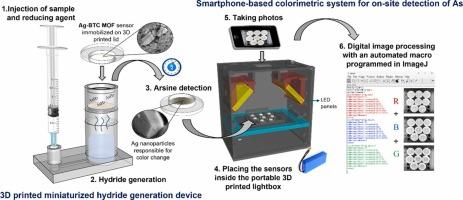Portable platform for smartphone-enabled arsenic detection using hydride generation and a silver-based metal-organic framework sensor
IF 3.7
1区 化学
Q1 CHEMISTRY, ANALYTICAL
引用次数: 0
Abstract
A portable sensor device was developed for on-site detection of arsenic (As(III)) using the hydride generation technique. The 3D-printed millifluidic device includes two zones: one for sample preparation and another for detection. The sensor zone consists of a silver-based metal-organic framework (Ag-MOF) immobilized with a polyvinylidene fluoride (PVDF) coating on a 3D-printed lid. The arsenic hydride (AsH3) generated in the sample preparation well reacts with the immobilized Ag-MOF, generating silver nanoparticles (AgNPs) that cause the color change from white to dark brown. Visual detection and colorimetric quantification were performed using a 3D-printed portable photo box with LED light panels, a smartphone for image capture, and ImageJ software for RGB analysis. The system required only 1 mL of sample and 5 min for the color reaction. Under optimal conditions, the method exhibited good linearity in two concentration ranges: 20–100 µg L−1 (low range) and 100–500 µg L−1 (high range). The detection limit (LOD) was 10 µg L−1, and the quantification limit (LOQ) was 20 µg L−1. Precision, expressed as relative standard deviation (RSD), ranged from 12.9 % to 9.5 %, with recoveries between 91 % and 104 % in milk and groundwater samples. Results were validated against ICP-OES and assessed using the AGREE and BAGI metric tools, confirming the method’s sustainability and practicality.

用于智能手机的便携式砷检测平台,使用氢化物生成和银基金属有机框架传感器
利用氢化物生成技术,研制了一种现场检测砷(As(III))的便携式传感器装置。3d打印的微流体装置包括两个区域:一个用于样品制备,另一个用于检测。传感器区域由银基金属有机框架(Ag-MOF)组成,该框架由3d打印盖子上的聚偏氟乙烯(PVDF)涂层固定。样品制备过程中产生的氢化砷(AsH3)与固定化Ag-MOF发生良好反应,生成银纳米粒子(AgNPs),使样品的颜色由白色变为深棕色。视觉检测和比色定量使用带有LED灯面板的3d打印便携式照相盒,用于图像捕获的智能手机和用于RGB分析的ImageJ软件进行。该系统只需要1 mL样品和5 min进行显色反应。在最佳条件下,该方法在20-100 µg L−1(低范围)和100-500 µg L−1(高范围)两个浓度范围内具有良好的线性关系。检测限(LOD)为10 µg L−1,定量限(LOQ)为20 µg L−1。精密度(以相对标准偏差(RSD)表示)范围为12.9 % ~ 9.5 %,加样回收率为91 % ~ 104 %。结果通过ICP-OES进行验证,并使用AGREE和BAGI度量工具进行评估,确认了该方法的可持续性和实用性。
本文章由计算机程序翻译,如有差异,请以英文原文为准。
求助全文
约1分钟内获得全文
求助全文
来源期刊

Sensors and Actuators B: Chemical
工程技术-电化学
CiteScore
14.60
自引率
11.90%
发文量
1776
审稿时长
3.2 months
期刊介绍:
Sensors & Actuators, B: Chemical is an international journal focused on the research and development of chemical transducers. It covers chemical sensors and biosensors, chemical actuators, and analytical microsystems. The journal is interdisciplinary, aiming to publish original works showcasing substantial advancements beyond the current state of the art in these fields, with practical applicability to solving meaningful analytical problems. Review articles are accepted by invitation from an Editor of the journal.
 求助内容:
求助内容: 应助结果提醒方式:
应助结果提醒方式:


